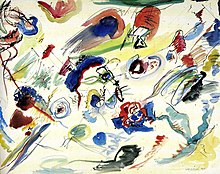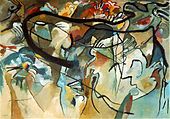Abstract art
Abstract art is a collective term for art movements of the 20th century that appeared after 1900. She uses the pictorial means of design partly - like Cubism - abstracting from the object, partly completely detached from nature and real objects (non-representational art) . Works of the first category show abstracted ("materialized", condensed to an essence) objects, figures, spaces. Works in the latter category make autonomous use of visual, artistic means, without any mimetic object reference. The spread of photography with its new quality of rendering of nature is seen as one of the reasons for the emergence of abstract art.
Beginnings and pioneers
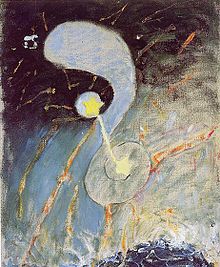
Shortly after 1900, the first painters and sculptors began to move further and further away from depicting the real world. Is known Kandinsky's path from a stylized, Munich Nouveau committed painting numerous stages of development to abstract compositions, the organic in the pure abstraction and geometric forms open. Programmatically, Kandinsky laid the theoretical basis for the new direction in painting with his work, written in 1910: On the Spiritual in Art . It is, however, debatable whether it should play the pioneering role in the history of the development of abstraction. According to his own statements, he painted his first non-representational picture in 1910. Today it is assumed that Kandinsky predated this picture, presumably he painted it only in 1913. The Czech František Kupka had already started painting abstract pictures in 1911.
However, according to a report by the journalist and historian Julia Voss in the Frankfurter Allgemeine Zeitung in April 2011, Hilma af Klint (1862–1944) is considered the first artist to paint abstract pictures . After a series of small-format pictures in November 1906, she created her first large-format picture in 1907. Other pioneers of abstract painting were the artists Sonia Delaunay-Terk , Robert Delaunay and Francis Picabia , the Dutchman Piet Mondrian and those in Switzerland and France acting Sophie Taeuber-Arp .
In sculpture, the actually non-representational works were only created around 1920 by the Ukrainian sculptor Alexander Archipenko , the Russian constructivist El Lissitzky and the English sculptor Henry Moore .
Theoretical limits and demarcation of non-representational art
The description of moments in art that are not subject to a mimetic reference to an object - a norm formulated historically in particular for the visual and performing arts, which can only be referred to music, architecture and literature with considerable restrictions - as an abstraction, however a possible perspective that contradicts the self-image of various currents in art history. Thus, the marginalized Suprematism Kasimir Malevich and Constructivism as irrelevant explicitly from the abstract art (such as Wassily Kandinsky ) from when illusionismusfreier creation of new concrete reality in the works of art (Suprematism) and creative design of material life (constructivism).
Parallels in music
The artists of abstraction moved parallel to the music of the time. There, with the dissonant release of the tonal value of the individual tones and the distance from the melody, something comparable to the release of the color tone from the object was created. The artists of the Blauer Reiters therefore sought to close ranks with composers like Arnold Schönberg , the founder of the twelve-tone technique .
Styles
Since its inception, abstract art has asserted its place in the art scene worldwide in ever new variants, styles and contexts. Her most important styles include constructivism and suprematism , geometric abstraction , abstract expressionism , informel , analytical painting and the art that emerged at the Bauhaus .
Artist (selection)


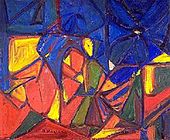

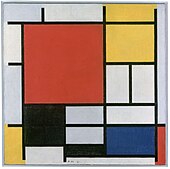
- Alexander Archipenko (1887–1964), sculptor
- Hans Arp (1886–1966), painter, sculptor and poet
- Giacomo Balla (1871-1958), painter
- Lucy Baker (* 1955), painter
- Willi Baumeister (1889–1955), painter and typographer
- Constantin Brâncuși (1876–1957), sculptor
- Peter Brüning (1929–1970), painter, graphic artist and object artist
- Alexander Calder (1898–1976), sculptor
- Jean-Michel Coulon (1920–2014), painter
- Robert Delaunay (1885–1941), painter
- Sonia Delaunay-Terk (1885–1979), painter and textile designer
- Jean Fautrier (1898–1964), painter
- Günter Fruhtrunk (1923–1982), painter
- Lucio Fontana (1899–1968), painter and sculptor
- Sam Gilliam (born 1933), painter
- Gotthard Graubner (1930–2013), painter
- Karl Otto Götz (1914–2017), painter and graphic artist
- Hans Hartung (1904–1989), painter and graphic artist
- Adolf Hölzel (1853–1934), painter
- Wassily Kandinsky (1866–1944), painter
- Yves Klein (1928–1962), painter
- Hilma af Klint (1862–1944), painter
- Willem de Kooning (1904–1997), painter
- František Kupka (1871–1957), painter
- Michail Fjodorowitsch Larionow (1881–1964), painter
- El Lissitzky (1890–1941), painter, graphic artist, architect and photographer
- Christoph Luger (* 1957), painter
- Kazimir Malevich (1878–1935), painter
- Georges Mathieu (1921–2012), painter
- Ludwig Merwart (1913–1979), painter, graphic artist
- Joan Miró (1893–1983), painter and sculptor
- László Moholy-Nagy (1895–1946), painter, designer and photographer
- Piet Mondrian (1872–1944), painter
- Henry Moore (1898–1986), sculptor
- Robert Motherwell (1915–1991), painter
- Ernst Wilhelm Nay (1902–1968), painter
- Barnett Newman (1905-1970), painter
- Kenneth Noland (1924-2010), painter
- Jules Olitski (1922–2007), painter and sculptor
- Graham Peacock (born 1945), painter
- Marta Pan (1923–2008), sculptor
- Francis Picabia (1879–1953), painter
- Jackson Pollock (1912–1956), painter
- Larry Poons (born 1937), painter
- Ad Reinhardt (1913–1967), painter
- Jean-Paul Riopelle (1923–2002), painter
- Mark Rothko (1903–1970), painter
- Emil Schumacher (1912–1999), painter
- Richard Serra (* 1939), sculptor
- Frank Stella (* 1936), painter and sculptor
- Sophie Taeuber-Arp (1889–1943), painter, sculptor, textile designer, interior architect
- Antoni Tàpies (1923–2012), painter and sculptor
- Cy Twombly (1928-2011), painter
- Victor Vasarely (1906–1997), painter
- Fritz Winter (1905–1976), painter
- Wols (1913–1951), painter
See also
literature
- Susanne Anna (Ed.): The informal - from Pollock to Schumacher . Hatje Cantz, Ostfildern 1999, ISBN 3-89322-689-3 .
- Dietmar Elger : Abstract Art . Taschen, Cologne 2008, ISBN 978-3-8228-5617-8 .
- Peter Haller (Ed.): Abstract Art after 1948 - Serviceplan Collection. Jovis, Berlin 2012, ISBN 978-3-86859-189-7 .
- Barbara Hess / Uta Grosenick (eds.): Abstract Expressionism. Taschen, Cologne 2005, ISBN 3-8228-2967-6 .
- Heinrich Lützeler : Abstract Painting, Gütersloh 1961
- Raphael Rosenberg : Turner, Hugo, Moreau. Discovery of abstraction . Exhibition catalog Schirn Kunsthalle, Frankfurt am Main. Hirmer, Munich 2007, ISBN 978-3-7774-3755-2 .
- Bettina Ruhrberg , Karl Ruhrberg : Under the sign of abstraction. On West German art 1945–1960 . In: Ferdinand Ullrich (Ed.): Art of the West. German art 1945–1960 . (Catalog of the art exhibition of the Ruhrfestspiele Recklinghausen 1996). Wienand Verlag, Cologne 1996, ISBN 3-87909-489-6 .
Web links
Individual evidence
- ↑ Nicola Carola Heuwinkel: Unlimited painting. Art Informel in Germany . Kehrer Verlag, Heidelberg / Berlin 2010, p. 22f.
- ↑ The colorful life. Wassily Kandinsky in the Lenbachhaus. Exhibition catalog Städtische Galerie im Lenbachhaus . Cologne: DuMont 1995. ISBN 3-7701-3785-X
- ↑ Dietmar Elger: Abstract Art . Taschen, Cologne 2008, p. 28.
- ↑ Julia Voss: The conqueror of the throne. In: FAZ. April 16, 2011, No. 90, p. 31.
- ↑ Andrei B. Nakov, Michel Petris: Avertissement the traducteurs . In: Nikolaj Tarabukin: Le dernier tableau . Éditions Champ Libre, Paris 1972. pp. 21-23.

